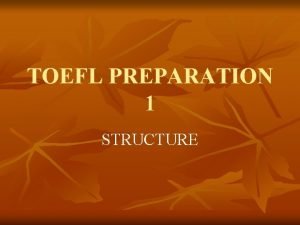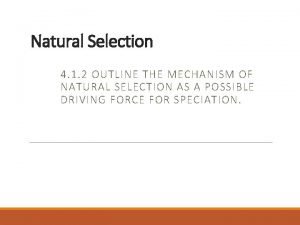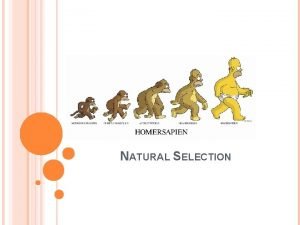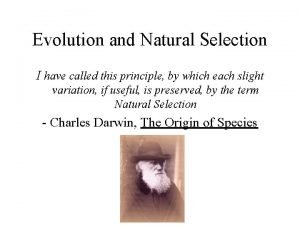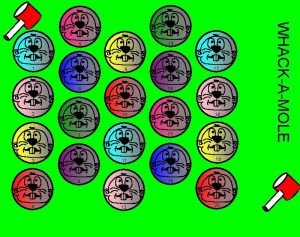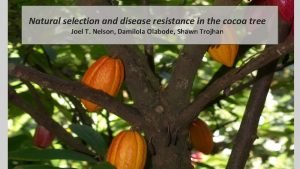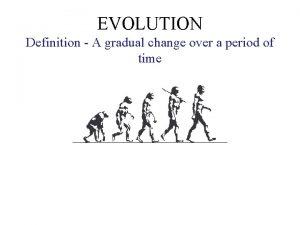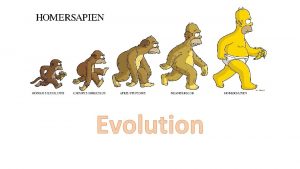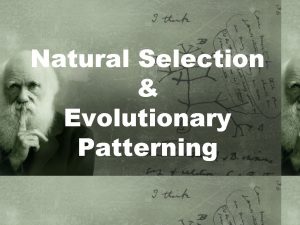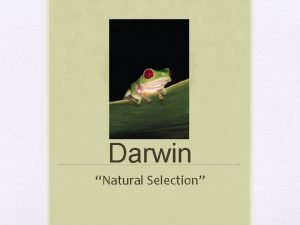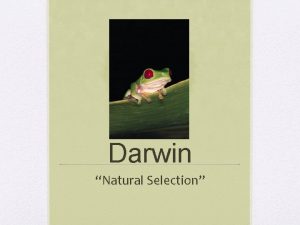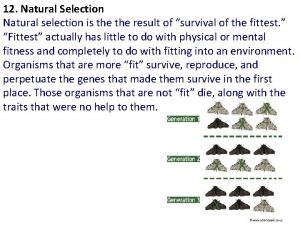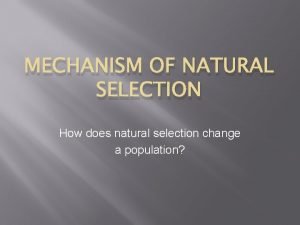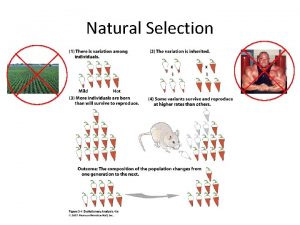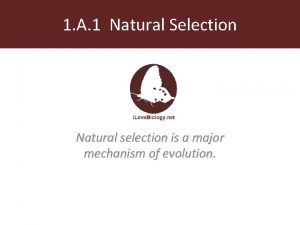Natural Selection II RAPID SELECTION Intense selection rapid



































- Slides: 35

Natural Selection II RAPID SELECTION (Intense selection, rapid evolution)

Natural Selection • Occurs when individuals differ in their reproductive success • Results in changes in allele frequencies in a population (genetic change over time) Eventually, this leads to morphological changes and, if accompanied by reproductive isolation, speciation. Hawian silverswords Darwin’s finches

Artificial versus rapid natural selection Is artificial selection analogous to natural selection? YES! *same basic mechanism (differential reproductive success) • NS = fitness related to environment • AS = “fitness” related to human preference

Classic examples of intense natural selection and subsequent rapid evolution • Antibiotic resistance • Antiviral resistance • Cichlids • Sticklebacks • Pocket mice • Darwin’s finches • Hawian silverswords • Fish in fisheries

Some lesser-known examples: • Snails shell morphology in northern New England • Escape ability in trinidad guppies • Copepods and dinoflagellates (if time) FEATURE EXAMPLES • Oxygen saturation and offspring survival (Becky) • Illustrates mechanisms of evolution • Reproductive isolation in African Drosophila (Raul) • Example of speciation

Questions How do these examples provide evidence for evolution? How can we use this information to help non-scientists understand evolution? What are the claims of evolution? What aren’t? What are we still uncertain about?

Conditions that favor rapid evolution • Quick generation time • Strong selective pressure • Available ecological niches (as on newly formed islands) long term evolution condensed into a short amount of time

Claims of evolution we’ll address in following examples • Differential survival and reporduction occurs in response to selective pressures • or is change guided by a divine hand? • Change occurs at the population, not individual level • or do individuals pass on acquired characteristics to their offspring? • Natural selection acts only on heritable variation • or do individuals pass on acquired characteristics to their offspring? • Natural selection is adequate to explain speciation and higher taxonomic level differences (common ancestry) • or do species have separate origins?

EXAMPLE 1 Morphology of Littoria obtusa in 1900 • High-spiraled • Thin-walled The range of Carcinus, an intertidal crab and predator of Littoria obtusa, expanded into northern New England in 1900. The crabs prefer high-spiralled, thinwalled snails to low spiralled, thick walled snails of the same species.

EXAMPLE 1 The range of Carcinus extended into Nova Scotia by 1986. Laboratory experiments showed that Carcinus prefers high-spiralled, thinwalled snails to low spiralled, thick walled snails. Morphology of Littoria obtusa after 1982 • Low-spiraled • Thick-walled

Morphology of snails collected before 1900. EXAMPLE 1 The predator provided strong selection for lowspiraled, thick-walled snails. Within 82 years, Littoria obtusa underwent dramatic morphological changes. Evidence that populations change in response to selective pressures Morphology of snails collected after 1982.

Trinidadian guppies and escape ability EXAMPLE 2 EXPERIMENTAL BACKGROUD Guppies were introduced into both high and low predation habitats. Twenty years later, 6 guppies were removed from a low-predation and 6 from a high predation habitat. They were placed in an enclosure with their natural predator, a cihlid. When the cichlid had consumed 1/2 of the guppies, the remaining guppies were removed and scored as to whether they came from high or low predation habitats. FINDINGS Guppies from high-predation populations had a much higher survival rate. Thus, they had improved escape ability.

Trinidadian guppies and escape ability EXAMPLE 2 BUT… Is escape ability a heritable trait? F 2 generation were tested from low and high predation habitats (bred and raised in predator-free enclosures). FOUND F 2 s of guppies from high predation populations had significantly greater escape ability

Trinidadian guppies and escape ability EXAMPLE 2 Conclusions Escape ability is acquired rapidly under the strong selection pressure of predation. Escape ability is a heritable trait. Evidence that natural selection acts on heritable variation

Offspring survival is greater among women with higher oxygen saturation levels at high elevations Background Populations at high altitudes are exposed to hypoxia (Hypoxia stresses the oxygen delivery system) Individuals differ in percent oxygen saturation of hemoglobin despite a uniform environment Oxygen saturation levels are determined by a single locus following Mendelian patterns of inheritance and dominance (locus is inferred only, not yet cloned) Could hypoxia be a selective pressure for higher oxygen saturation levels?

THE STUDY • Collected geneaological, oxygen saturation genotype, and female fertility data from 3812 people in 14 villages between 3800 and 4200 m in the Tibet Autonomous Region of China from November 1997 to August 2000 FOCUS OF TODAY’S DISCUSSION • Analyzed data on fertility events and oxygen saturation genotype from a subgroup of 20 - 59 year old married women

Genotype AB and BB oxygen saturation level of hemoglobin 10% higher than AA

SUMMARY OF RESULTS High saturation genotypes were significantly correlated with: (1) lower infant mortality (2) higher number of surviving offspring

For which claims of evolution does this example provide evidence? Four main claims of evolution indroduced at the beginning • Differential survival and reproduction occurs in response to selective pressures • or is change guided by a dinivne hand? • Change occurs at the population, not individual level • or do individuals pass on acquired characteristics to their offspring? • Natural selection acts only on heritable variation • or do individuals pass on acquired characteristics to their offspring? • Natural selection is adequate to explain speciation and higher taxonomic level differences (common ancestry) • or do species have separate origins?

How is this an example of evolution? Natural selection acts only on heritable variation Number of individuals with the BB and AB genotypes increase dramatically with each generation Change occurs at the population, not individual level Frequency of B alleles increase in the populations Differential survival and reproduction occurs in response to selective pressures The change in allele frequency in the populations is NATURAL SELECTION due to the intense selective pressure of hypoxia. We don’t know whether increased survivorship is due to having healthier mothers, each individual having higher oxygen saturation level, or a combination of the two.

AA Starting population, AB, = AA = BB and After one generation, the B alleles make up a higher proportion of the population With each successive generation, the B alleles increase in frequency. AB

We’ve provided one answer to the first question, “How is this evidence for evolution? ” In the conclusion, we’ll consider how to use this information to help people understand evolution. • anti-evolutionary arguments are often based on misconceptions about what evolution is and is not • education is needed

References of primary examples O’Steen, S. et al. Rapid evolution of escape ability in Trinidadian guppies. 2002 Evolution 56: 776 -784 Seely, R. H Intense natural selection caused a rapid morphological transition in a living marine snail. 1986 PNAS; 83: 6897 -6902. Beall, C. M. et al. Higher offspring survival among Tibetan women with high oxygen saturation genotypes residing at 4, 000 m. 2004 PNAS; 101: 14300– 14304

BIBLIOGRAPHY of further examples Antibiotic and antiviral resistance Davies J. Inactivation of antibiotics and the dissemination of resistance genes. Science 1994; 264: 375 -82. Palumbi, S. R. Humans as the world’s greatest evolutionary source. Science 2001; 293; 1786 -1790 Rambaut, A. et al. The causes and consequences of HIV evolution. Nature Reveiews Genetics 2004; 5: 52 -61 Ciclids Kocher TD. 2004. Adaptive evolution and explosive speciation: the cichlid fish model. Nature Reviews Genetics 5: 288 -298 Danley PD and Kocher TD. 2001. Speciation in rapidly diverging systems: lessons from Lake Malawi. Molecular Ecology 10: 1075 -1086

Stickleacks Boughman, J. W. et al. . 2005. Parallel evolution of sexual isolation in sticklebacks. Evolution 59: 361– 373. Pocket mice Nachman, M. W. , H. E. Hoekstra, and S. D’Agostino. 2003. The genetic basis of adaptive melanism in pocket mice. Proc. Natl. Acad. Sci. USA 100: 5268– 5273. Darwin’s finches Grant, P. R. Ecology and Evolution of Darwin's Finches: (With a New Preface and Afterward) 1999 (book) Princeton University Press Hawiian Silverswords Baldwin, B. G. and M. J. Sanderson. Age and rate of diversification of the Hawaiian silversword alliance (Compositae) 1998; Evolution 95: 9402 -9406 Fish in fisheries Olsen, E. M. et al. Maturation trends indicative of rapid evolution preceded the collapse of northern cod. 2004; Nature 428; 932 -935

Sexual Isolation in Drosophila Melanogaster http: //www. geocities. com/mssever/gallery/photo/welcome_to_zimbabwe. jpg Incipient Speciation

Incipient Speciation • Strong sexual isolation between the Zimbabwe and the worldwide Drosophila melanogaster

Strong Case • Zimbabwe population is not a different species • Limited gene flow between populations • Unique genetic variability in Zimbabwe • Some DNA differences are nearly fixed • Mating Preference (Wu et al. 1995)

No Choice Experiment • • Five females and males in same vial Recorded copulations after 1 hr and 1 day Seven Z female lines rarely mated with C males Two Z female lines mated more frequently with C males (intermediate types) • C females mated with Z males but not as quickly as with C males • Results generally agree, measure possibly affected by experimental conditions

Multiple Choice Experiment • Z and C flies given different colored food • Place males and females from Z and C together • Discrimination Index (DI) measures within-type preference (DI > 3 means strong isolation) • All Z and C lines show significant sexual isolation • Bidirectional, stronger between Z females and C males • Intermediate types show intermediate preferences • Complete isolation between D. melanogaster and D. simulans

Mating Behavior is Heritable • Hybrid males attract Z females better than C males but worse than Z males • Hybrid male success depends on competitor; strongly suggests female choice • Hybrid females are less discriminate toward C males; most will settle for C males if given no choice • Genetic trickery => “zimbabweness” in major autosomes • No evidence of hybrid sterility or inviability • 2006: handful of loci involved in male mating success and female preference, complex network

Cosmopolitan male Zimbabwe Female

Reproductive Isolation in Sockeye Salmon • Between ancestral river and an introduced lake population in less than 13 generations (~70 years) • Lake population is genetically distinct despite some gene flow • Lake males have deep bodies, immigrant males have shallower bodies for river swimming • Lake females are smaller than immigrant females; large size in river facilitates nest building • Lake body plans confer reproductive advantage Hendry et al. 2000 Science


But they haven’t speciated… • Be glad • Rare glimpse into the speciation process • Evolution at work: differential reproductive success within members of a species • Rapid vs. great opportunities to study speciation events
 Natural selection vs artificial selection
Natural selection vs artificial selection Difference between continuous and discontinuous variation
Difference between continuous and discontinuous variation What is artificial selection
What is artificial selection Similarities
Similarities Natural selection vs artificial selection
Natural selection vs artificial selection An intense play activity that requires substantial energy
An intense play activity that requires substantial energy During intense exercise potassium tends to accumulate
During intense exercise potassium tends to accumulate Environmentalists are earnestly trying to determine
Environmentalists are earnestly trying to determine Extensive verb
Extensive verb Indication of tens
Indication of tens Plot structure linear
Plot structure linear Trevor spends 45 minutes a day in front of an intense light
Trevor spends 45 minutes a day in front of an intense light Abate definition romeo and juliet
Abate definition romeo and juliet Natural hazards vs natural disasters
Natural hazards vs natural disasters Natural income
Natural income Mechanism of evolution
Mechanism of evolution Evolution graphic organizer
Evolution graphic organizer Homologous structures
Homologous structures How big are jaguars teeth
How big are jaguars teeth Natural selection is the unequal survival that results
Natural selection is the unequal survival that results Natural selection examples
Natural selection examples Natural selection vocabulary
Natural selection vocabulary Chapter 15 section 1 darwins theory of natural selection
Chapter 15 section 1 darwins theory of natural selection Natural selection
Natural selection Natural selection
Natural selection Who formulated theory of evolution? *
Who formulated theory of evolution? * Criteria for natural selection
Criteria for natural selection As ecological development proceeds, a biological community
As ecological development proceeds, a biological community Natural selection
Natural selection Natural selection vs evolution
Natural selection vs evolution Natural selection
Natural selection Jeopardy evolution
Jeopardy evolution Types of natural selection in evolution
Types of natural selection in evolution Evolution
Evolution Stabilizing selection human birth weight
Stabilizing selection human birth weight 4 principles of natural selection
4 principles of natural selection







